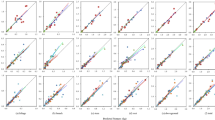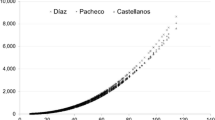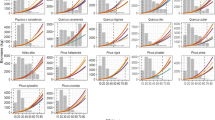Abstract
Since biomass is one of the key variables in ecosystem studies, widespread effort has aimed to facilitating its estimation. Numerous stand-specific volume and biomass equations are available, but these cannot be used for scaling up biomass to the regional level where several age-classes and structural types of stands coexist. Therefore simplified generalized volume and biomass equations are needed. In the present study, generalized biomass and volume regression equations were developed for the main tree species in Europe. These equations were based on data compiled from several published studies and are syntheses of the published equations. The results show that these generalized equations explain 64–99% of the variation in values predicted by the original published equations, with higher values for stem than for crown components.


Similar content being viewed by others
Notes
Forest inventories use as volume functions mostly equations other than allometric equations.
The R 2 and the root-mean-square error of the generalized volume and biomass equations were used to assess the variability of these equations relative to the original equations. These apply to the pseudoobservations generated and do not express the accuracy relative to the field data but indicate the amount of variation in predictions by the original equations accounted for by the generalized equations.
References
Ahti T, Hämet-Ahti L, Jalas J (1968) Vegetation zones and their sections in northwestern Europe. Ann Bot Fenn 5:169–211
Burger H (1937) Holz, Blattmenge und Zuwachs: Nadelmenge und Zuwachs bei Föhren und Fichten verschiedener Herkunft. Mitteilungen der Schweizerischen Anstalt für das Forstliche Versuchswesen 20:101–114
Burger H (1953) Holz, Blattmenge und Zuwachs: Fichten im gleichalterigen Hochwald. Mitteilungen der Schweizerischen Anstalt für das Forstliche Versuchswesen 29:38–130
Dietrich H (1968) Untersuchungen zur Nährstoffdynamik eines Fichtenbestandes. Archiv für Forstwesen 17:391–412
Do-Hyung L (2001) Relationship between above- and below-ground biomass for Norway spruce (Picea abies): estimating root system biomass from breast height diameter. J Korean For Soc 90:338–345
Eamus D, McGuinness K, Burrows W (2000) Review of allometric relationship for estimating woody biomass for Queensland, the Northern Territory and Western Australia. Aust Greenhouse Office, Canberra. In: National Carbon Accounting System Technical Report 5A:1–56
Enquist BJ, Niklas KJ (2001) Invariant scaling relations across tree-dominated communities. Nature 410:655–660
Iyengar S (1991) Much ado about meta-analysis. Change 4:33–40
Jenkins JC, Chojnacky DC, Heath LS, Birdsey RA (2003) National-scale biomass estimators for United States tree species. For Sci 49:12–35
Jenkins JC, Chojnacky DC, Heath LS, Birdsey R (2004) Comprehensive database of diameter-based biomass regressions for North American tree species. United States Department of Agriculture, Forest Service, General Technical Report NE-319:1–45
Keith H, Barrett D, Keenan R (2000) Review of allometric relationship for estimating woody biomass for New South Wales, the Australian Capital Territory, Victoria, Tasmania and South Australia. In: The Australian Greenhouse Office, Canberra, National Carbon Accounting System Technical Report 5B:1–113
Marklund LG (1987) Biomass functions for Norway spruce (Picea abies (L.) Karst.) in Sweden. Sveriges lantbruksuniversitet, Rapporter–Skog 43:1–127
Marklund LG (1988) Biomassafunktioner för tall, gran och björk i Sverige. Sveriges lantbruksuniversitet, Rapporter–Skog 45:1–73
Näslund M (1937) Skogsförsöksanstaltens gallringsförsök i tallskog. Meddelanden från Statens Skogsförsökanstalt 29:1–169
Pastor J, Aber JD, Melillo JM (1983/1984) Biomass prediction using generalized allometric regressions for some northeast tree species. For Ecol Manage 7:265–274
Peña D (1997) Combining information in statistical modeling. Am Stat 51:326–332
Ranta E, Rita H, Kouki J (1999) Biometria. Helsinki University Press, Helsinki
Schmitt MDC, Grigal DF (1981) Generalized biomass estimation equation for Betula papyrifera Marsh. Can J For Res 11:837–840
Snee RD (1977) Validation of regression models: methods and examples. Technometrics 19:415–428
Snowdon P, Eamus D, Gibbons P, Khanna P, Keith H, Raison J, Kirschbaum M (2000) Synthesis of allometrics, review of root biomass and design of future woody biomass sampling strategies. In: The Australian Greenhouse Office, Canberra, National Carbon Accounting System Technical Report 17:1–114
Stone M (1974) Cross-validatory choice and assessment of statistical predictions. J R Stat Soc 36:111–147
Ter-Mikaelian MT, Korzukhin MD (1997) Biomass equations for sixty-five North American tree species. For Ecol Manage 97:1–24
West GB, Brown JH, Enquist BJ (1999) A general model for the structure and allometry of plant vascular systems. Nature 400:664–667
Whittaker RH, Woodwell GM (1968) Dimension and production relations of trees and shrubs in the Brookhaven Forest, New York. J Ecol 56:1–25
Wirth C, Schumacher J, Schulze E-D (2004) Generic biomass functions for Norway spruce in central Europe—a meta-analysis approach toward prediction and uncertainty estimation. Tree Physiol 24:121–139
Vinš B, Šika A (1981) Biomasa smrkového porostu v chlumní oblasti. Práce VÚLHM 59:83–99
Vyskot M (1990) Aboveground biomass of adult Norway spruce. Acta Sc Nat Brno 24:1–36
Zianis D, Mencuccini M (2003) Aboveground biomass relationship for beech (Fagus moesiaca Cz.) trees in Vermio Mountain, Northern Greece, and generalised equations for Fagus spp. Ann For Sci 60:439–448
Zianis D, Mencuccini M (2004) On simplifying allometric analyses of forest biomass. For Ecol Manage 187:311–332
Zianis D, Muukkonen P, Mäkipää R, Mencuccini M (2005) Biomass and stem volume equations for tree species in Europe. Silva Fennica Monographs 4, 63 pp
Acknowledgments
This study was a part of the EU-funded research consortium ‘Multi-source inventory methods for quantifying carbon stocks and stock changes in European forests’ (CarboInvent EKV2-2001-00280). I thank Dr. Raisa Mäkipää, Dr. Aleksi Lehtonen and Mr. Mikko Peltoniemi for their comments on the manuscript, Dr. Emil Cienciala for providing the aggregated height values per age-class based on data of forest management plans in the Czech Republic, Dr. James Thompson for editing the English language and the Finnish National Forest Inventory for providing data on permanent sample plots.
Author information
Authors and Affiliations
Corresponding author
Additional information
Communicated by Michael Köhl.
Appendices
Appendix 1
The modelled relationships between dbh and h were tested, reserving a portion of the available data to obtain an independent measure of the model prediction accuracy. When no test set is available for model validation, a cross-validation criterion can be used (Stone 1974; Snee 1977). Model validation was accomplished with the leave-one-out (LOO) cross-validation. The dataset is split into a training set, on which a model is estimated, and a test set on which the model is evaluated. In this case the response value ŷ (i) is predicted on a model that was estimated for the dataset minus the ith observation, while the test set contains only one observation (Stone 1974). The splitting procedure is repeated until all observations have once and only once been in the test set. Thus there are n models built, each using n−1 observations for model construction and the remaining observations for model validation. The LOO cross-validation criterion mPRESS (mean of the predictive error sum of squares) is most often used (Stone 1974; Snee 1977):
in which n is the number of observations in the test set and y i and ŷ (i) are, respectively, the experimental and predicted response values. Taking the square root of this, we can derive the root-mean-square error of cross-validation:
The relative mean error of cross-validation was also calculated:
Appendix 2
The dissimilarity \( {\left( {H_{0} :\beta ^{{{\text{BOR}}}}_{1} = \beta ^{{{\text{TEM}}}}_{1} ;H_{1} :\beta ^{{{\text{BOR}}}}_{1} \ne \beta ^{{{\text{TEM}}}}_{1} } \right)} \) of parameters \( \beta ^{{{\text{BOR}}}}_{1} \) and \( \beta ^{{{\text{TEM}}}}_{1} \) (Table 3) was tested using the test statistic t (Ranta et al. 1999):
where the standard error \( s_{{\beta ^{{{\text{BOR}}}}_{1} - \beta ^{{{\text{TEM}}}}_{1} }} \)is given by
where the n BOR and the n TEM are the sample sizes. The error variance was assumed to be of equal size in both populations. The \( {\left( {s_{{Y \cdot X}} ^{2} } \right)}_{p} \) is the so-called pooled variance estimator and is given by
The \( SS_{{{\text{RESIDUAL}}}} ^{j} \)follows:
The \( {\left( {n^{j} - 1} \right)}s_{X} ^{2} {\left( j \right)} \), \( {\left( {n^{j} - 1} \right)}s_{Y} ^{2} {\left( j \right)} \) and \( {\left( {n^{j} - 1} \right)}s_{{XY}} {\left( j \right)} \) were calculated from
and
respectively.
If the error variance is normally distributed and the errors of different values of the explanatory variable are independent, the test statistic follows the t-distribution with \( n_{{{\text{BOR}}}} + n_{{{\text{TEM}}}} - 4 \) degrees of freedom.
Rights and permissions
About this article
Cite this article
Muukkonen, P. Generalized allometric volume and biomass equations for some tree species in Europe. Eur J Forest Res 126, 157–166 (2007). https://doi.org/10.1007/s10342-007-0168-4
Received:
Accepted:
Published:
Issue Date:
DOI: https://doi.org/10.1007/s10342-007-0168-4




